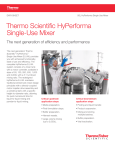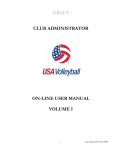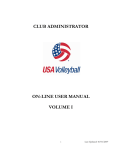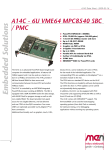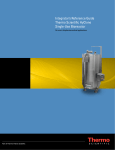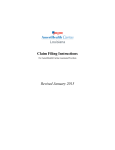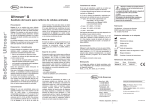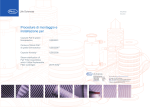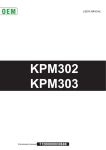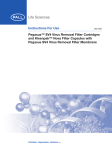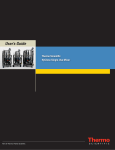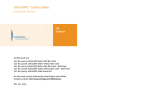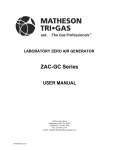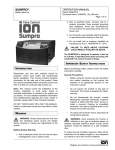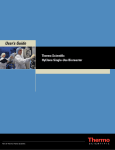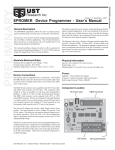Download Application Note Preparation, Use, and Integrity T
Transcript
Application Note USTR 2512 Preparation, Use, and Integrity Testing of Pall Ultipor® VF DV20 Filter Cartridges and Capsules Table of Contents Table of Contents 1. Basic Recommendations for Use.......................................................................... 1 1.1 Introduction......................................................................................................................... 1 1.2 Typical Process Steps ........................................................................................................... 1 2. Filling Procedures................................................................................................ 2 2.1 T-Style Configurations......................................................................................................... 2 2.1.1 Stainless Steel Filter Housing (e.g., Pall Advanta ALT) ......................................................2 2.1.2 T-Style Capsule Filter (e.g., Kleenpak™ Nova Capsule)......................................................3 2.2 In-Line Configurations ........................................................................................................ 3 2.2.1 Stainless Steel Filter Housing (e.g., Pall Advanta In-Line)..................................................4 2.2.2 In-Line Capsule Filter (e.g., In-Line (e.g., Kleenpak Nova or Novasip Capsule) ................5 3. Preparation for Pre-use Integrity Testing ............................................................ 6 3.1 Flushing Using a Pump Arrangement .................................................................................. 6 3.1.1 Pump Selection..................................................................................................................6 3.1.2 Flushing Pressure ...............................................................................................................6 3.2 Flushing Using a Pressure Arrangement ............................................................................... 6 4. Pre-use Integrity Testing ..................................................................................... 7 5. Conditioning the Filter for Processing................................................................. 7 6. Processing ........................................................................................................... 8 6.1 Processing Using a Pump Arrangement................................................................................ 8 6.2 Processing Using a Pressure Arrangement ............................................................................ 8 7. Minimizing Product Loss .................................................................................... 8 8. Preparing Filters for Post-Use Integrity Testing .................................................. 8 9. Post-use Integrity Test Flushing .......................................................................... 9 9.1 Flushing Using a Pump Arrangement .................................................................................. 9 9.2 Flushing using a Pressure Arrangement................................................................................ 9 10. Post-use Integrity Testing ................................................................................. 9 11. Further Guidance for Integrity Testing ............................................................. 9 11.1 Failure Analysis/Troubleshooting....................................................................................... 9 12. Typical Flush Volumes for Pall Ultipor VF DV20 Filters and Capsules........... 10 13. Filter Return Procedure................................................................................... 10 14. Frequently Asked Questions ............................................................................ 11 15. Customer Service............................................................................................. 13 Table of Contents Page i List of Figures List of Figures Figure 1: Pall Advanta T-Line Filter Housing ...................................................................................2 Figure 2: Kleenpak Nova Capsule in a T-Style Configuration ..........................................................3 Figure 3: Pall Advanta Filter Housing in an Inverted Position...........................................................4 Figure 4: Pall Advanta Filter Housing in a Standard Position............................................................4 Figure 5: Pall In-Line Kleenpak Nova Capsule Filter in an Inverted Position ....................................5 Figure 6: Pall Novasip Capsule Filter in a Standard Position ............................................................5 List of Tables Table 1: Minimum Filling Time .....................................................................................................2 Table 2: Typical Flush Volumes for Pall Ultipor VF DV20 Filters and Capsules...........................10 Table 3: Prefilter Recommendations..............................................................................................12 Page ii Preparation, Use, and Integrity Testing of Pall Ultipor VF DV20 Filter Cartridges and Capsules Basic Recommendations for Use 1. Basic Recommendations for Use 1.1 Introduction The information contained within this guide is intended for guidance only. It contains a set of recommendations for a basic mode of operation and is not intended to discuss all possible process variables. For more information or technical support, see Section 15: Customer Service on page 13. Pall Ultipor® VF DV20 filters are direct flow filters that remove viruses essentially by size exclusion. Due to the small pore size required to remove viruses, these filters exhibit lower liquid flow characteristics when compared to filters and capsules utilizing sterilizing-grade membranes. These lower flow rates influence several aspects of use including wetting and subsequent operation. Pall can also provide fully automated integrated virus filter systems that provide the highest level of process safety and efficiency. These systems offer precise and consistent automated process steps for improved process efficiency and reduced labor costs. 1.2 Typical Process Steps A typical process flow includes but may not be limited to: 1. 2. 3. 4. 5. 6. 7. 8. Filter installation[1] Filter filling Filter wetting and flushing Pre-use integrity testing Process filtration Product recovery by flushing with a compatible fluid Filter wetting Post-use integrity testing Ultimately, the procedures used must satisfy any process-specific validation requirements. (1) Detailed assembly, installation and sterilization procedures (if required) are described in the Pall publications listed under Assembly and Installation on page 13 in Section 15: Customer Service. Typical Process Steps Page 1 T-Style Configurations 2. Filling Procedures The first contact of the filter with process fluids, wetting agents, or filling fluids needs to be carefully controlled to ensure even and complete wetting at later stages. Pall recommends that filling be implemented from bottom to top on a filter being held in a vertical position, bubble free, in a time not faster than 5 minutes for a 10-inch high filter (Table 1). Table 1: Minimum Filling Time Cartridge Size Cartridge Type Minimum Filling Time (min) 84 mm (3.3 in.) CLM05 2 254 mm (10 in.) AB1, NT6, NP6 5 508 mm (20 in.) AB2, NT7, NP7 10 762 mm (30 in.) AB3, NT8, NP8 15 Typical filter installations schemes that will allow ensuring correct wetting are described in Section 2.1: T-Style Configurations on page 2 and Section 2.2: In-Line Configurations on page 3. 2.1 T-Style Configurations 2.1.1 Stainless Steel Filter Housing (e.g., Pall Advanta® ALT) A typical configuration for filling a virus filter in a stainless steel housing (from a pump or pressurized vessel) is displayed in Figure 1. Figure 1: Pall Advanta T-Line Filter Housing Vent In Out Drain Page 2 Preparation, Use, and Integrity Testing of Pall Ultipor VF DV20 Filter Cartridges and Capsules Filling Procedures 2.1.2 T-Style Capsule Filter (e.g., Kleenpak™ Nova Capsule) T-Style capsule filters should be assembled like stainless steel housings. An assembled T-Style Kleenpak Nova capsule is shown as an example (Figure 2). Figure 2: Kleenpak Nova Capsule in a T-Style Configuration Vent In Out Drain 2.2 In-Line Configurations Installation of filters with an in-line configuration requires a careful attention. By positioning the housing or capsule with the head down, filling can be done from bottom to top assuring optimum filling conditions. This position does not allow full condensate removal during steaming, however, and should not be used if in-situ steaming is to be implemented. When in-situ steaming is to be implemented for filter housings or Novasip™ capsules, in-line filters should be installed in the standard position. However, in order to allow filter filling from bottom to top, the fluid should be admitted into the housing through the lower drain connection (only during the filling operation). Figures 3 – 4 display typical configurations. In-Line Configurations Page 3 In-Line Configurations 2.2.1 Stainless Steel Filter Housing (e.g., Pall Advanta In-Line) Inverted Position Figure 3: Pall Advanta Filter Housing in an Inverted Position Out Vent Drain In Tubing Drain Standard Position Figure 4: Pall Advanta Filter Housing in a Standard Position In Vent (Filling only) Drain Out Page 4 Preparation, Use, and Integrity Testing of Pall Ultipor VF DV20 Filter Cartridges and Capsules Filling Procedures 2.2.2 In-Line Capsule Filter (e.g., In-Line (e.g., Kleenpak Nova or Novasip Capsule) Inverted Position (e.g., In-Line Kleenpak Nova Capsule) Figure 5: Pall In-Line Kleenpak Nova Capsule Filter in an Inverted Position Out Vent Drain In Tubing Drain Standard Position (e.g., Novasip Capsule Filter) Caution: Kleenpak Nova filter capsules cannot be in-situ steamed. Only Pall Novasip capsule filters are validated for in situ steaming Figure 6: Pall Novasip Capsule Filter in a Standard Position Vent Drain In Out (Filling only) In-Line Configurations Page 5 Flushing Using a Pump Arrangement 3. Preparation for Pre-use Integrity Testing While water as a wetting fluid may be acceptable for performing a pre-use integrity test, there can be process benefits from the use of alcohol. These benefits have been seen to include: • reduced flushing time • less need for filter retesting due to insufficient wetting • increased sensitivity Pall recommends, therefore, that where possible, filter integrity testing be performed using 0.1 μm prefiltered 30/70 v/v isopropanol (IPA)/water or 20/80 ethanol (EtOH)/water as the wetting fluid. The validation of, and the flushing recommendations for the integrity testing of Pall Ultipor VF DV20 filters, when wet with water (30/70 v/v IPA/water or 20/80 v/v EtOH/water), is discussed in Validation and Flushing on page 13 in Section 15: Customer Service. 3.1 Flushing Using a Pump Arrangement 3.1.1 Pump Selection The chosen pump should be capable of providing approximately 3.5 barg (50.8 psig) at the required process flow rate. It is also essential that flow and pressure do not pulsate during the flushing and processing operations. Such pressure pulsations can have an adverse effect on wetting effectiveness by forcing air into the filtration media. In extreme circumstances these fluctuations may damage the filters being flushed. Pall therefore recommends the Quattroflow* series of pumps for these applications. 3.1.2 Flushing Pressure The Pall publications mentioned above detail various pressure recommendations for the flushing of Ultipor VF DV20 filters using various fluids. In general, any wetting regime is enhanced with the application of higher pressures, these are ultimately limited by the maximum pressure claims for the filters. Both inlet pressure and back-pressure increase the effectiveness of the flushing regime by compressing and eliminating residual gas from the membrane construction. 1. 2. 3. 4. 5. 6. 7. 8. Condition the filter as per Section 2: Filling Procedures on page 2. Ensure that all air is purged from the housing using the appropriate vent valve. Slowly increase the pump speed to generate an inlet pressure of 2.1 barg (30 psig). When the pressure is stable, carefully close the downstream valve to apply back-pressure. Increase the back-pressure until the inlet pressure and back-pressure are appoximately 3.5 barg (50.8 psig) and 1.5 barg (21.8 psig) respectively. Flush the filter for 20 minutes, adjusting pump speed and back-pressure to maintain the inlet and outlet pressure. After 20 minutes open the back-pressure valve and wait for the outlet pressure to decay to ~0 bar. Reduce the pump speed until the inlet pressure reads 0 bar. Drain the excess fluid from the upstream side of the filter housing or capsule. 3.2 Flushing Using a Pressure Arrangement There are issues that must be considered when fluid is transferred using a pressurized vessel. These include the dissolution of gas into the flushing and process fluids during the extended pressurization of the reservoir during flushing. During the transfer of these fluids, pressure changes can cause the dissolved gas to form micro-bubbles within the filtration media. This may lead to localized partial non-wetting and subsequent integrity test failures. It is recommended that this is evaluated at full scale as part of the process qualification. Page 6 Preparation, Use, and Integrity Testing of Pall Ultipor VF DV20 Filter Cartridges and Capsules Pre-use Integrity Testing To minimize the dissolution of gas, Pall recommends that the reservoir is pressurized for the shortest possible period and is sized appropriately to minimize the fluid area available for gas transfer. 1. 2. 3. 4. 5. 6. 7. 8. Condition the filter as per Section 2: Filling Procedures on page 2. Ensure that all air is purged from the housing using the appropriate vent valve. Slowly increase the pressure on the wetting fluid reservoir to generate an inlet pressure of 1.5 barg (21.8 psig). When the fluid exits the system, partially close the back-pressure valve. Adjust the reservoir pressure and backpressure valve to obtain appoximately 3.5 barg (50.8 psig) inlet pressure and 1.5 barg (21.8 psig) back-pressure. Flush the filter for 20 minutes, adjusting the reservoir pressure and back-pressure valve to maintain the inlet and outlet pressure. After 20 minutes open the back-pressure valve and wait for the outlet pressure to decay to ~0 bar. Reduce the reservoir pressure to 0 bar. Drain the excess fluid from the upstream side of the filter housing or capsule. 4. Pre-use Integrity Testing If testing offline, 1. Connect the integrity test instrument to the housing or capsule. 2. Ensure that all other upstream connections are closed or blanked using an appropriate blanking fitting. 3. Integrity test the filter using the integrity test data issued by Pall for the assembly under test. Please refer to the user manual, Palltronic Flowstar XC Test Instrument Operating Manual (USD2005) for further guidance. If testing in-situ, 1. Ensure that the downstream side of the filter housing / capsule remains at atmospheric pressure. This is best achieved by connection to suitably large volume or by being open to atmosphere via a sterilizing grade gas filter. 2. Isolate the upstream side of the assembly under test by closing the necessary valves immediately upstream of the filter housing or capsule. 3. Connect the integrity test instrument to this isolated upstream volume. Appropriate connection points include the filter housing, capsule, or connecting pipework. 4. Integrity test the filter using the integrity test data issued by Pall for the assembly under test. 5. Conditioning the Filter for Processing While the exact requirements will depend upon the proposed process, in conjunction with full system draining, it is recommended that the residual wetting fluid be displaced using a buffer that is compatible with the process fluid. Studies using 30/70 IPA/water have shown that volumes in the order of 5 L /10-inch filter can reduce residual solvent immediately downstream of a filter capsule to < 50 ppm. Ultimately the removal of solvent should be determined using a simulated process with specific consideration being given to the impact of additional downstream pipe-work, tubing or other connections that may not be free draining. After flushing the filter housing/capsule should be drained using an appropriate drain valve. Flushing Using a Pressure Arrangement Page 7 Processing Using a Pump Arrangement 6. Processing 6.1 Processing Using a Pump Arrangement 1. Slowly increase the pump speed to fill the housing/capsule, allowing displaced air to vent using an appropriate vent valve. 2. Close the housing vent valve when the housing or capsules are full. 3. Slowly increase the pump speed until the inlet pressure reaches the validated process pressure. 4. Adjust the pump speed to maintain the validated process pressure. 5. When processing is complete, stop the pump. It is recommended that measurements of time, pressure and volume processed are recorded throughout the filtration operation. 6.2 Processing Using a Pressure Arrangement 1. Isolate the reservoir from the filters by closing a valve immediately upstream of the filters. 2. Slowly increase the reservoir pressure to the validated process pressure. 3. Partially open the isolating valve until the housing/capsule is full, allowing displaced air to vent using an appropriate vent valve. 4. Close the housing/capsule vent valve when the housing or capsules are full. 5. Fully open the isolating valve. 6. Process until the reservoir is empty. 7. Close the isolating valve and slowly depressurize the reservoir. 8. Depressurize the housing/capsule by slowly opening the housing/capsule vent valve. 7. Minimizing Product Loss Where the process allows, yields can be maximized by allowing the residual process fluid to be recovered using a buffer flush or other compatible fluid. Typically up to 3x the hold-up volume is recommended; however, exact volume requirements depend upon the system. 8. Preparing Filters for Post-Use Integrity Testing Exposure of product residues to incompatible fluids, potentially including the wetting fluid, may cause denaturing or aggregation of the product, making removal of these residues by the wetting flush less likely. The presence of product residues on the filter membrane may have an adverse effect on the wettability of the membrane. Full wetting of the membrane is essential for the successful integrity testing of the filter. If not already displaced by a product recovery flush, it is recommended that product residues be flushed from the filter using a compatible fluid prior to flushing with the wetting fluid. Page 8 Preparation, Use, and Integrity Testing of Pall Ultipor VF DV20 Filter Cartridges and Capsules Post-use Integrity Test Flushing 9. Post-use Integrity Test Flushing 9.1 Flushing Using a Pump Arrangement To flush using a pump arrangement, use the procedure detailed in Section 3.1.2: Flushing Pressure on page 6. 9.2 Flushing using a Pressure Arrangement To flush using a pump arrangement, use the procedure detailed in Section 3.2: Flushing Using a Pressure Arrangement on page 6. 10. Post-use Integrity Testing For post-use integrity testing, use the procedures detailed in Section 4: Pre-use Integrity Testing on page 7. 11. Further Guidance for Integrity Testing The Integrity test parameters for Ultipor VF DV20 capsules and filters should be obtained in advance by contacting Pall Scientific and Laboratory Services. It is recommended that the test time is set to a minimum of 15 minutes (900 seconds) to allow complete stabilization. 11.1 Failure Analysis/Troubleshooting Following an integrity test failure, it is advised that the following be investigated: 1. Ensure there are no upstream leaks: (i) Tighten all connections and if necessary disconnect and reconnect any joints. (ii) Test the valves on the capsule by leak spray or by submerging that portion of the capsule or filter housing in water and looking for bubbles. (iii) If hardware leaks are observed on the capsule vents, open and close the vents a number of times to solve the problem, if this is not successful, please return the products following the return procedure detailed in Section 13: Filter Return Procedure on page 10. 2. Test assemblies using multiple capsules or housings individually to establish the location of the apparent failure. 3. Ensure environmental temperature is stable and the filter is not exposed to drafts or radiant heat. If stability problems are encountered, shield the filter under test and the connecting tubing. This can be accomplished by: (i) insulating the test tubing with additional sleeving, (ii) covering the filter and tubing with a suitable cover, or (iii) placing the entire assembly in a closed-off fume cupboard or isolator. If stability problems still occur, the filter assembly may be immersed in water (at room temperature) and tested, but it is essential that water is not allowed to enter the outlet of the filter capsule. 4. Retesting If points 1– 3 have been checked, and apparent integrity test failures are observed, repeat the flushing cycle. Failure Analysis/Troubleshooting Page 9 Failure Analysis/Troubleshooting PDA Technical Report No. 41, Virus Filtration 6.4 Failure Analysis/Troubleshooting If a virus filter fails an integrity test it could be damaged, but there may be other causes for the failure. Any investigation of filter failure or retesting should be described in a standard operating procedure. Part of the investigation should distinguish between filter damage and possible test problems or artifacts. To confirm corrective action, in the case of Forward/ Diffusion, Pressure Hold/Decay and Leak Tests, re-wet the filter according to the specifications and repeat the test. If the filter integrity test fails again, the Forward/Diffusion, Pressure Hold/Decay or Leak Tests may be performed in a lower-surface-tension reference fluid (where specified by the filter manufacturer) to assess filter wetability changes independent of filter integrity. 12. Typical Flush Volumes for Pall Ultipor VF DV20 Filters and Capsules Table 2: Section 3 5 7–8 9 Typical Flush Volumes for Pall Ultipor VF DV20 Filters and Capsules AB1DV20 AB2DV20 AB3DV20 CL(M)05DV20 NP6DV20 NP7DV20 NP8DV20 0.07 m2 1 m2 2 m2 3 m2 Typical 30/70 v/v IPA/water flush volume for pre-IT testing(1) 0.3 L 3L 6L 9L Water flush for solvent removal post-IT testing 0.5 L 5L 10 L 15 L Typical pre-use buffer flush volume(2) 50 mL 1L 2L 3L Typical post-use buffer flush volume(2),(3) 50 mL 1L 2L 3L Typical 30/70 IPA/water flush volume for post-use IT testing(3) 0.3 L 3L 6L 9L Typical Filter Area (1) See Section 3: Preparation for Pre-use Integrity Testing on page 6. (2) If dilution is problematic, the pre-use and post-use buffer flushes may be eliminated. It is however advisable to incorporate a flush at these stages to minimize product losses through adsorption and fluid retention. Flushing with buffer or water prior to the IPA flush for integrity testing is recommended to avoid potential product residue interactions, which may alter the surface characteristics and hence the wettability of the membrane (Section 8 on page 8). (3) If there is significant post-use blockage, the flow rate at this stage may be greatly reduced. The volume required for flushing may therefore be reduced to avoid excessive flushing time. See Section 3: Preparation for Pre-use Integrity Testing. Should apparent integrity test failures be observed, repeating the flushing cycle at this stage may assist (Section 11.1 on page 9). 13. Filter Return Procedure In the event of having to return a filter for further evaluation, please contact your local sales representative. 1. Please ensure that a completed Material Safety Data Sheet accompanies any returned filter. 2. Please supply as much information as possible regarding the filter use and any tests performed. Page 10 Preparation, Use, and Integrity Testing of Pall Ultipor VF DV20 Filter Cartridges and Capsules Frequently Asked Questions 14. Frequently Asked Questions Can I flush and process using a pressure vessel or do I need a pump? Both methods are acceptable although there are practical considerations. Any pump should be chosen to supply a controllable and constant pressure. Where processing is performed under defined flow conditions, it is essential that the pressure is monitored at all times and the maximum pressure specifications or validated flow rates are not exceeded. Blockage of the filters during filtration will lead to an increase in the differential pressure at the set flow rate therefore pressure needs to be constantly monitored and the pump adjusted to prevent over pressurization of the system. Filtration using a pressurized vessel can drive the fluid through the filter under a constant pressure of up to 3 barg (43.5 psig). Using this arrangement supervision can be kept to a minimum, and where blockage does occur the flow rate will simply decline. It is recommended that the process flow rate be monitored using this technique.[] Pressurization of fluid over prolonged periods can increase the amount of dissolved gas in the process fluid. Natural pressure changes across the filtration media may cause the fluid to degas, potentially forming trapped air bubbles within the filtration media. These bubbles may adversely affect the observed flow rate and wetting of the filters. Pall recommends the Quattroflow* series of pump for medium to large-scale processes. These would include CLM05DV20 size capsules and larger. How do you recommend flushing the filter prior to integrity testing? Two ways to set up your system are shown below. In both instances, a pressure of 3.5 bar (50.8 psi) should be generated upstream, with the downstream valve partially closed to provide a back-pressure of 1.5 bar (21.8 psi). It is highly recommended that the flow rate be monitored and recorded to ensure slow filling and is documented together with the corresponding integrity test results. Refer to Figures 3 – 6 for the flushing setup. Does my process require any prefiltration? One of the key advantages of Ultipor VF filters is that they can tolerate a higher level of filter plugging species, and their constant pressure/flux capabilities can handle more complex or concentrated feeds. Therefore Ultipor VF virus filters require less extensive, less complex prefiltration, thereby minimizing the risk of premature fouling and flux decay as compared to other virus filters. Although minimal prefiltration is required, Pall recommends that all fluids are prefiltered to at least 0.2 μm (preferably to 0.1 μm). For the process fluid it is recommended that a filterability assessment be performed on a representative fluid to establish the likely throughput and degree of blockage of the intended filtration system. Prefiltration may significantly increase the life of the intended virus filter or reduce the process time by minimizing the reduction in flow rate associated with filter blockage. Prefiltration is also highly recommended if there is any storage prior to the virus filtration. Even if 0.2 μm or 0.1 μm filtration prior to storage was performed, there is potential for aggregation, which may have a detrimental effect on the life of the virus filter, to occur. Failure Analysis/Troubleshooting Page 11 Failure Analysis/Troubleshooting Some typical prefilter recommendations can be seen below. Table 3: Prefilter Recommendations Process Fluid First Prefilter Very clean fluids such as monoclonal antibodies after purification by chromatography Supor® EKV Fluorodyne® DFL Second Prefilter Final Filter Not required Ultipor VF DV20 Not required Ultipor VF DV20 Ultipor N66 NF Typical combination for many fluids Fluorodyne DJL Supor EKV Typical combination for plasma fractionation Fluorodyne DFL Ultipor VF DVD Ultipor VF DV20 Ultipor N66 NF Supor EKV Fluids with very fine impurities not removed by 0.1 μm or DVD prefiltration. Fluorodyne DFL Ultipor VF UDV50 Ultipor VF DV20 Pegasus™ ULV6 How do I incorporate a prefilter into my system? There are two ways in which prefiltration can be accomplished. 1. Filter through the prefilter into a holding vessel and then from the holding vessel through the virus filter. This can be performed as shown above in two separate operations. 2. Attach the prefilter immediately upstream of the virus filter. Unless the prefilter blocks prematurely, this will provide little restriction to the flow through the system. For assistance with process optimization, pleaee contact Pall. Pall can also design and supply customized disposable solutions to facilitate the prefiltration, virus filtration, sterile filtration and storage of filtered product. These can be supplied at all scales to accommodate fast and reliable process scale-up. How can I avoid dilution? If dilution is problematic, the pre-use and post-use buffer flushes may be eliminated. It is however advisable to incorporate a flush at these stages to minimize product losses through adsorption and fluid retention. Flushing with buffer or water prior to the IPA flush for integrity testing is recommended to avoid potential product residue interactions, which may alter the surface characteristics and hence the wettability of the membrane (Section 8 on page 8). How do I handle significant flow decay due to blockage? If there is significant post-use blockage, the flow rate at this stage may be greatly reduced. The volume required for flushing may therefore be reduced to avoid excessive flushing time. See Section 3: Preparation for Pre-use Integrity Testing. Should apparent integrity test failures be observed, repeating the flushing cycle at this stage may assist (Section 11.1 on page 9). Page 12 Preparation, Use, and Integrity Testing of Pall Ultipor VF DV20 Filter Cartridges and Capsules Customer Service 15. Customer Service Pall Scientific and Laboratory Services (SLS) is happy to help expedite your application procedures and to help you satisfy your process-specific validation requirements. Assembly and Installation Detailed assembly, installation, and sterilization (if required) procedures are described in the following Pall publications: • • • • USTR 805, Steam Sterilization of Pall Filter Assemblies USD 2291, Assembly and Installation Procedures for Pall Pharmaceutical Grade Capsule Assemblies USD 2296, Assembly and Installation Procedures for Pall Pharmaceutical Grade Filter Cartridges USD 2398, Assembly and Installation Procedures for Pall Novasip Capsule Assemblies Validation and Flushing The validation and flushing recommendations for the integrity testing of Pall Ultipor VF DV20 filters when wet with water is discussed in: • USTR 2341, Validation of Forward Flow Integrity Test Parameters for Water Wet Filter Cartridges, and • USTR 2405, Forward Flow Procedure for Water Wet Pall Ultipor VF DV20 AB Style Virus Removal Filter Cartridges The validation of, and flushing recommendations for the integrity testing of Pall Ultipor VF DV20 filters when wet with 30/70 v/v IPA/water or 20/80 EtOH/water is discussed in: • VG-DV20, Pall Ultipor VF Grade DV20 AB Style Virus Removal Filter Cartridges Validation Guide • USTR 2324, Pall Ultipor VF Grade DV20 AB Ultipleat Style Virus Removal Filter Cartridges Validation Guide Flushing Volumes The information given above is for guidance only, and in part is taken from the method used for the validation of Ultipor VF DV20 membrane filters (Pall publication No. VG-DV20). The application of process knowledge together with individual validation or process specific requirements may require changes to be made. Pall can assist and comment on any proposed changes that may be necessary. Failure Analysis/Troubleshooting Page 13 Failure Analysis/Troubleshooting Page 14 Preparation, Use, and Integrity Testing of Pall Ultipor VF DV20 Filter Cartridges and Capsules Pall has the most comprehensive family of scalable separation products. New York — USA +1 800 717 7255 +1 516 484 5400 +1 516 801 9548 [email protected] toll free telephone fax e-mail Portsmouth — Europe +44 (0)23 9230 3303 telephone +44 (0)23 9230 2506 fax [email protected] e-mail Visit us on the web at www.pall.com/biopharmaceutical Pall Corporation has offices throughout the world in locations including: Argentina, Australia, Austria, Belgium, Brazil, Canada, China, France, Germany, India, Indonesia, Ireland, Italy, Japan, Korea, Malaysia, Mexico, the Netherlands, New Zealand, Norway, Poland, Puerto Rico, Russia, Singapore, South Africa, Spain, Sweden, Switzerland, Taiwan, Thailand, United Kingdom, the United States, and Venezuela. Distributors are located throughout the world. All data, specifications and information contained in this publication are based on information we believe reliable and represent values in effect at the time of printing. Pall Corporation reserves the right to make changes without prior notice. , Pall, Fluorodyne, Kleenpak, Novasip, Palltronic, Pall Advanta, Pegasus, Supor, and Ultipor are trademarks of Pall Corporation. Filtration.Separation.Solution. and UpScale are service marks of Pall Corporation. Quattroflow is a trademark of Quatroflow Fluid Systems. Part Numbers quoted above are protected by the Copyright of Pall Corporation. ® indicates a trademark registered in the USA. © 2007, Pall Corporation. 03/08, USTR 2512




















